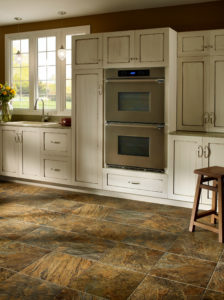 How often are you lured by a product that promises to make your life effortlessly more simple? How many times do you hear, “get more for less” or “the most bang for your buck” in one day? Only in today’s economic climate would a word like bogo—buy one, get one—enter the national business lexicon.
How often are you lured by a product that promises to make your life effortlessly more simple? How many times do you hear, “get more for less” or “the most bang for your buck” in one day? Only in today’s economic climate would a word like bogo—buy one, get one—enter the national business lexicon.
Most people are pressed for time, money and resources and look to multitask wherever possible. Flooring is no exception. If Mrs. Consumer wants a wood floor but learns she can have exactly that look at a lower cost with easier installation and maintenance, she’ll jump at the chance. Authenticity in her home is purely cosmetic.
For most retailers, the resilient category combines features from multiple categories without sacrificing profit. As a whole it has been gaining momentum during the economic slump but it is more than just a value story.
“It’s a reinvention and repositioning of the category,” said David Sheehan, vice president of resilient and laminate business, Mannington Residential. “Upgraded looks, new technologies and product innovations have come at a time when vinyl just seems to make sense to the consumer from an economic standpoint.”
Performance in 2010
As the second largest category behind carpet, resilient continues to outperform other segments, although most believe it will be down slightly from 2009’s numbers, which were 2.298 billion square feet accounting for $1.281 billion in sales. “For resilient sheet, we see both dollars and units down about 2% for 2010,” said Kim Holm, president, Mannington Residential Business.
While the category continues to provide profit opportunities, competition has also increased. “It seems like new players are coming out of the wood work,” 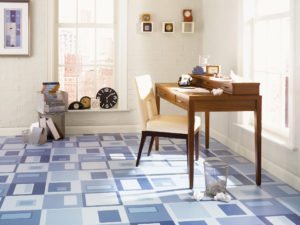 said Michael Raskin, president, Metroflor. “The category is more competitive with everyone jumping in as it is the fastest growing segment in the industry.”
said Michael Raskin, president, Metroflor. “The category is more competitive with everyone jumping in as it is the fastest growing segment in the industry.”
With a great wear story that requires minimal cleaning and maintenance, time-pressed homemakers can reap the advantages of minimal chore time with resilient options. Afternoons spent cleaning or refinishing floors are unnecessary with wood-style resilient floors, and sealing solutions are no longer needed on stone looks.
Take Armstrong, a mill that entered the resilient category more than 100 years ago. “We’ve taken our first-class CleanSweep surface—long recognized for its exceptional stain resistance—to the next level,” said Alan Cubell, vice president of sales and marketing. “New CleanSweep Plus provides both incomparable stain and scratch resistance.”
Installation has also seen great improvement with the advent of adhesive-free technologies. From loose-lay sheet methods to floating LVT systems, preparation and install has never been faster.
“Given the state of the economy, a value-oriented category like resilient overshadows more expensive products,” Cubell said. “Consumers no longer looking to invest in their homes but rather refresh or repair their homes, will be looking for beauty with great value and we feel that is great potential for resilient.”
Sentiment at Tarkett is also focused on the value story, with consumers entering the flooring market lacking preconceived notions about vinyl flooring. “This actually opens up the entire category to a large consumer base that may never have considered resilient sheet flooring products,” said Gary Finseth, marketing director, Tarkett Residential. “This new normal in value and performance consumer spending is a great opportunity to educate them on alternatives that present great design, style and quality while bet- ter meeting their budgetary needs.”
Why has the resilient category changed so much from last year? It could be argued the change in the resilient category is in response to changes in the American consumer. It has a wear story that appeals to the consumer’s sense of value and economy, and has come a long way in terms of visuals.
“Consumers are savvy and will not settle for anything less than a great-looking floor, regard- less of budget,” said Lise LeBreton, creative director, Tarkett Residential. “But it is also important to understand this because the printing process has come a long way in the last couple of years. The quality of our resilient product visuals and their ability to replicate authentic materials is imperative.”
Inkjet, high definition printing advances have given mills the ability to replicate most materials with remark- able realism. Earlier this year, Mannington began using Omni HD printing on its sheet products that print authentic-looking grout lines for tile patterns and sharp veining on marble and travertine looks.
Along those lines, Armstrong is introducing Masterworks 3D print technology which facilitates looks as good as the natural inspiration, making for an easy sell. “Like a high-definition television, MasterWorks 3D captures the innate depth, definition and dimension of natural materials,” Cubell said. “Stones look and feel like stones and wood looks and feels like wood.”
Visual trends follow natural counterparts
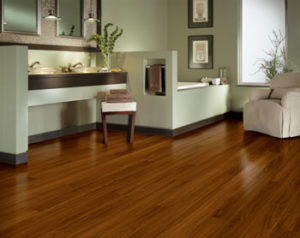 With the ability to realistically imitate wood and stone, styles in resilient flooring are mimicking trends in those natural categories. Conservative spending on conservative styles that stand the test of time has been predominant with a little more risk taking as the economy has grown.
With the ability to realistically imitate wood and stone, styles in resilient flooring are mimicking trends in those natural categories. Conservative spending on conservative styles that stand the test of time has been predominant with a little more risk taking as the economy has grown.
“Consumers seek product designs that are long lasting, and for that reason we have seen growth in popularity of neutrals, stone and tile colorations,” LeBreton said. She cited mid- to darker-tones as a far cry from the light taupes and beiges long associated with resilient products, particularly in wood tones that have gone from the exotic reds to more neutral browns. “Natural, mid-wood tones are our highest-volume items.”
Metroflor, a manufacturer of exclusively resilient flooring, has also seen a copycat trend residentially. Raskin said sophisticated oak looks are becoming more popular. “Designs are simple but with more sophisticated colors and finishes, such as oil stains from light to dark with deeper variation.” On the designer end of the spectrum, washed concretes and clean granites in cool tones are still prominent with a highlight on metals.
Felt vs. fiberglass
Felt still holds a strong presence at 70% of the sheet market, prompting Tarkett to expand its offerings in that construction. Mario Allard, director of resilient products, Tarkett Residential, said with the tremendous features it offers, they lend themselves to a well-positioned sell-up opportunity without an overwhelming cost difference.
He also finds Tarkettt’s consumers appreciate its FiberFloor, the fiberglass-backed product that is warm and comfortable underfoot, water- and moisture-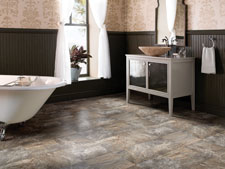 resistant, stands up to scratches, scuffs, stains and indentations, is easy to maintain and is affordable.
resistant, stands up to scratches, scuffs, stains and indentations, is easy to maintain and is affordable.
“Today, FiberFloor provides style and design that has not been seen in sheet vinyl before and offers installation in either loose-lay or full spread,” Allard said. “It is no surprise that Tarkett’s FiberFloor, and the category as a whole, is growing.”
Sheehan found the category migrating away from felt toward fiberglass. “Felt still has many desirable attributes—in Mannington’s case it even has an environmental story because it contains recycled content—but fiberglass offers visuals and an ease of installation that makes it a very attractive option,” he said.
As a well-known, standard style of the category, manufacturers across the board are improving sheet portfolios in either backing. Armstrong has constructed a brand new fiberglass facility for a refreshed product line and a new merchandising system that Cubell said was designed to drive sales for retailers in the face of a demanding economy with four unique product structures to meet different installation and lifestyle demands. Duality has a new fiberglass structure for fashionable performance; CushionStep is about flexibility in application and living; StrataMax is a ‘rock back’ floor with 70% stone composite in the bottom layer for durability, and ToughGuard Felt is the tried-and-true felt-backed vinyl.
“New technology and new style ideas come together to enhance the beauty, performance and comfort of vinyl floors in qualities that are in-step with what people today want to buy,” he explained.
LVT: The star of the show
Luxury vinyl tile (LVT) possesses all the attributes that make the resilient category so appealing. Durability, ease of installation and maintenance, great visuals, flexibility in application; all of these apply here. LVT comes in stone, wood, tile or more unique looks like Metroflor’s m9 in Natural Scenes of rocks or green grass, a newer addition to the mill’s LVT family.
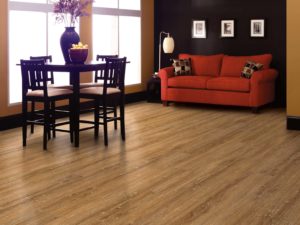 After a reasonable gestation period in the market, Raskin sees the subcategory moving toward glueless or click systems, based on demand from consumers. “Within LVT, floating installation systems are growing the most rapidly,” said Mannington’s Sheehan. New systems like LockSolid on Adura coupled with realistic designs have given the category potential to explode over the next few years because it gives the retail salesperson a meaning- ful differentiator to discuss with the consumer.
After a reasonable gestation period in the market, Raskin sees the subcategory moving toward glueless or click systems, based on demand from consumers. “Within LVT, floating installation systems are growing the most rapidly,” said Mannington’s Sheehan. New systems like LockSolid on Adura coupled with realistic designs have given the category potential to explode over the next few years because it gives the retail salesperson a meaning- ful differentiator to discuss with the consumer.
Differentiation has brought new players to the stage, like Wicanders and USFloors. Known primarily for their cork products, these manufacturers have unique LVT offerings with cork infusions.
“While the material cost for a Vinacork floor may be slightly higher than glue down LVT, the installed cost for Vinacork is significantly less due to a faster install and minimal floor preparation,” said Gary Keeble, marketing manager, USFloors. He said its floor is much more forgiving to subfloor imperfections than glue down products, where the slightest imperfection can telescope through the floor and basically ruin the look of it altogether.
Matt Fasick, Southeast sales manager, Amorim Flooring, said the addition of cork creates a contrast to most LVTs. “Cork has two important built-in benefits: comfort and sound absorption. The ‘ahh’ & ‘shh’ features add real, tangible value.”
Glueless systems are gaining favor, with a triple bottom line for the buyer: looks, ease of installation and worry-free maintenance. “We are so excited about the category that we launched our floating line, Luxe Plank, early this year and it’s been phenomenal,” Cubell said. “The authentic looks are breathtaking; new, pressure- sensitive adhesives make these floors simple to install, and the water-resistant performance is superior.”
An extensive offering of true click systems is on the horizon but are already available from Mannington in LockSolid and Metroflor in its Hybrid and Laminique collections. Most successful LVTs with click systems utilize a license previously applied on laminate products. “If people are going to choose a click system, it is better using an HDF core because it has long history and proven track record,” Raskin said. “With our Konecto patent, we’ve got that test built into our Hybrid product.”
He said one thing was for certain: “The market is growing, and we plan on growing with it.”
-Emily Hooper
